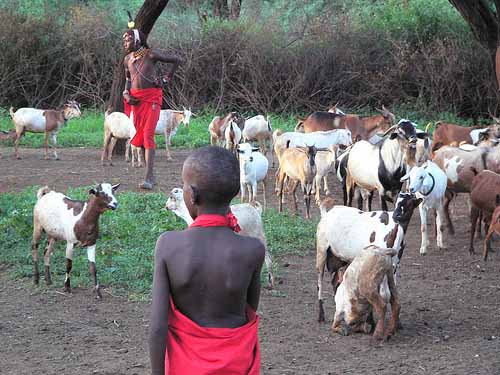|
Author: Kay Holekamp In our research camp in the eastern Mara we have two night watchmen, or “askaris” in Kiswahili. Their names are Stephen and Lusingo, and they both hail from manyattas across the river from our camp. Last night disaster struck at Stephen’s manyatta, resulting in what can only be described as a catastrophic loss of livestock.
Sometime between midnight and 1 am, a leopard climbed over the 8-foot wall of one of the livestock corral’s in Stephen's manyatta, grabbed a goat, and fled back over the wall. (This morning Stephen found the leopard asleep on a high tree-branch beside the river, with Stephen's goat --now dead, of course-- tucked into a fork in the tree.) Perhaps detecting the scent of blood from the leopard attack, a spotted hyena then approached Stephen’s manyatta, and forced its way into the same livestock corral. The terrified sheep and goats (“shoats”) stampeded and burst out of the corral through a weakly closed gate, and dispersed into the night on the open plain, where they were promptly set upon by a large group of hyenas. Stephen, who was at work guarding our camp at the time, received a call on his cell phone at 1 am telling him the hyenas were mowing down his shoats, so he rushed home. None of the hyena researchers in camp were aware then of what had happened, but this morning Stephen found us and led us to his manyatt, where the scene can only be described as carnage: dead and damaged shoats all over the place, and the surviving shoats huddled together, still apparently terrified. Women and men were trying to salvage what meat they could from the carcasses of the dead ones, and cleaning what was left of the skins. Stephen had tallied the losses, which totaled 50 shoats, each valued at roughly 3000 Kenya shillings ($45.00 US). We have no funds for any sort of compensation scheme here, so all we could do today was to buy several kilos of shoat meat at filet mignon prices to help Stephen recoup some of his losses. This is one of those situations where, despite the fact that the killer hyenas were not among the ones we study, nor did we have anything to do with this awful event, the hyena researchers feel absolutely terrible for Stephen and his family, as this represents a huge financial loss. We will now do whatever we can to help them cope with this disaster, including strengthening their corrals to keep out marauding predators in the future.
0 Comments
Your comment will be posted after it is approved.
Leave a Reply. |
About
Notes From Kenya is a blog run by the students in the Holekamp Lab at Michigan State University, College of Natural Science, East Lansing, Michigan, U.S.A. Archives
July 2020
Categories |

 RSS Feed
RSS Feed